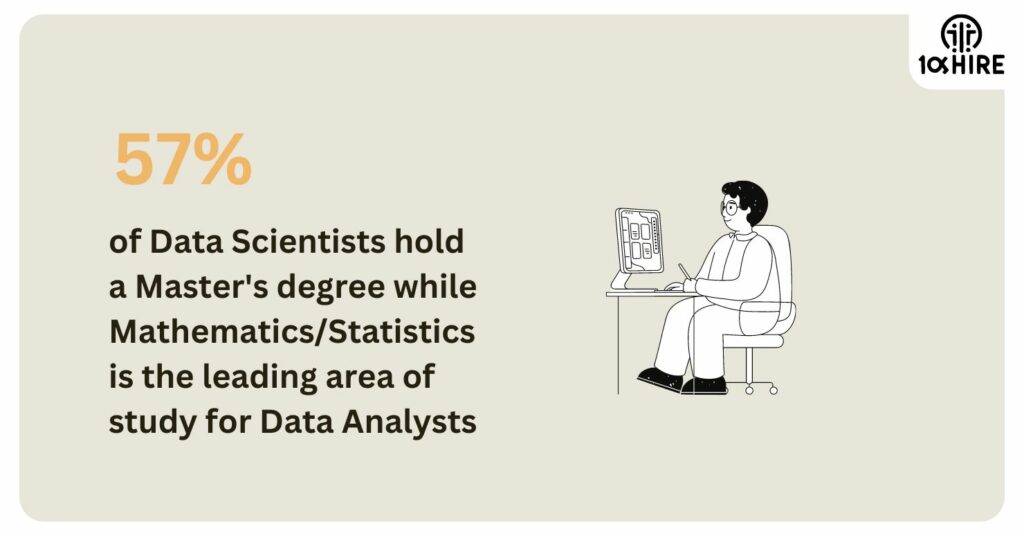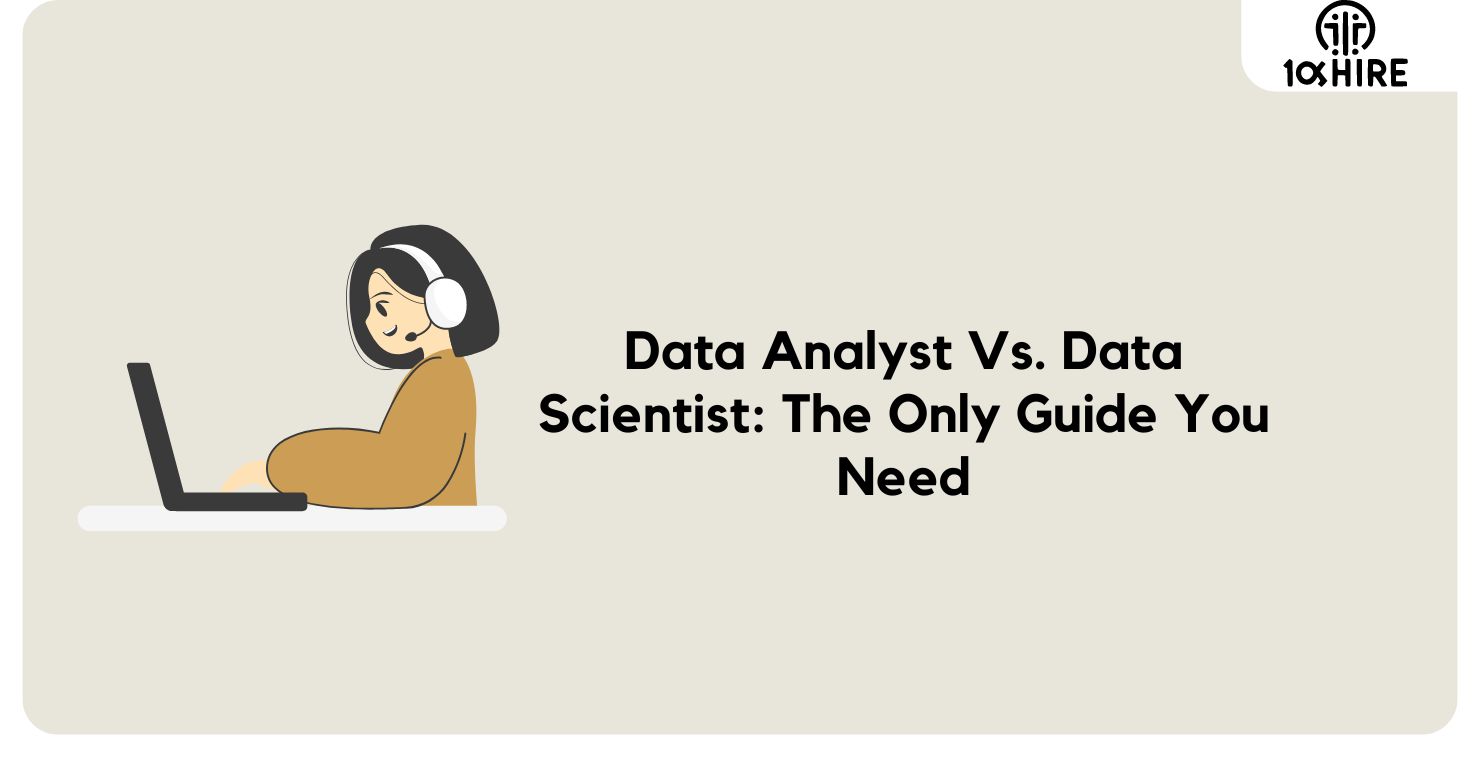Choosing between data scientist vs data analyst role can be tough. Both careers are in high demand and pay well. This guide explains the differences and how each fits into the world of big data and machine learning.
To become a data analyst, many people study math and statistics. This is the top field of study for 37% of data analysts. They also learn about databases, statistical analysis, and how to use tools like SAS for understanding data.
Table of Content

Understanding the Roles of a Data Analyst and Data Scientist
Data analysts and data scientists have distinct roles, including varied educational requirements, key skills, and career growth. Data analysis involves exploring, cleaning, and visualizing data while drawing insights for decision-making.
On the other hand, data science focuses on problem definition, model building and training to make predictions and solve complex problems through advanced technologies.
What Does a Data Analyst Do?
A data analyst collects and cleans data, performs exploratory data analysis, conducts statistical analysis, and visualizes data to support decision-making. To learn more about the exciting world of data analytics, keep reading!
Data collection and cleaning
Data collection involves gathering data from various sources such as databases, APIs, and web services. Once collected, the data needs to be cleaned to ensure accuracy and consistency.
This process includes handling missing values, removing duplicates, and transforming unstructured data into a usable format. Data cleaning is crucial for maintaining the quality of the dataset before it undergoes analysis.
Data wrangling plays a significant role in preparing the data for analysis by reshaping and restructuring it into a usable form. Feature engineering also contributes to this process by creating new features that enhance the predictive power of machine learning models.
Exploratory data analysis
Data analysts perform exploratory data analysis (EDA) to identify patterns and relationships within datasets. Using techniques like summary statistics, visualizations, and correlation analysis, they uncover valuable insights that inform business decisions.
EDA is crucial in understanding the structure of the data and detecting anomalies or trends that could influence predictive analytics models.
Exploratory data analysis serves as a foundational step for both descriptive analytics and predictive modeling. By employing tools such as statistical analyses, histograms, scatter plots, and box plots, analysts gain a comprehensive view of the dataset’s characteristics and distribution.
Statistical analysis
Statistical analysis involves using mathematical methods to analyze and interpret data patterns. It helps in identifying trends, correlations, and making predictions based on the data gathered.
57% of Data Scientists hold a Master’s degree while Mathematics/Statistics is the leading area of study for Data Analysts (37%). This showcases the importance of statistical knowledge in both roles and its impact on the decision-making process.
When it comes to statistical analysis, various machine learning techniques like classification, probability, and statistical models are employed. This aids in understanding complex data sets and making informed decisions.
Data visualization
Transitioning from statistical analysis to data visualization, it is crucial for both data analysts and data scientists to present their findings effectively. Data visualization enables professionals to communicate complex information clearly using charts, graphs, and dashboards.
It plays a vital role in business intelligence and decision-making processes.
Effective data visualization can be achieved through tools like Tableau, Power BI, and QlikView. These platforms allow the creation of interactive visualizations that provide actionable insights to support strategic business decisions.
Moreover, the use of Python libraries such as Matplotlib and Seaborn enhances the presentation of quantitative analyses.
Data-driven decision-making
Data-driven decision-making involves using data to inform business choices. This process integrates statistical analysis and data mining to uncover insights that guide strategic initiatives.
57% of Data Scientists hold a Master’s degree, emphasizing the need for a strong educational background in this field. The Burtch Works Study from 2021 shows a growing demand for professionals skilled in data-driven decision-making, with 73% of companies planning to hire data science and analytics experts in the near future.
What Does a Data Scientist Do?
A data scientist defines problems, collects and pre-processes data, builds and trains models, interprets results, and communicates findings. To learn more about the exciting world of data science, keep reading!
1. Problem definition
Data scientists start by clearly defining the problem they aim to solve using data. This involves understanding the business or research question that needs to be addressed and formulating it in a way that can be tackled with quantitative analysis.
Here, their expertise in problem-solving and critical thinking is essential in shaping the direction of their work, ensuring it aligns with the overall objectives of the project or organization.
Additionally, data analysts also engage in problem definition; however, their focus tends to revolve around specific historical data issues rather than broader strategic or theoretical problems commonly tackled by data scientists.
Recommended Read: What Is UX Designer Salary In India And The World?
2. Data collection and preprocessing
Transitioning from problem definition to data collection and preprocessing is a pivotal step toward solving analytical challenges. Data scientists are responsible for gathering and cleaning raw information before delving into the model-building process.
This involves extracting, transforming, and loading (ETL) processes to ensure the data is structured and ready for analysis. They employ big data technologies such as Hadoop, Hive, and cloud computing tools to manage large datasets efficiently.
Additionally, they meticulously handle complexities in data engineering to underpin machine learning applications effectively.
3. Model building and training
Data scientists perform problem definition, data collection, and preprocessing before embarking on model building and training. They then meticulously select machine-learning algorithms and perform hyperparameter tuning to enhance the models’ performance.
After this, interpretable models are deployed for sharing insights with stakeholders, unlocking the secrets hidden in the data.
Data analysts often use statistical tools such as R programming for constructing predictive models. Then they employ cross-validation techniques to validate the robustness of these models before employing them for decision-making.
4. Interpretability and deployment
Transitioning from model building and training to interpretability and deployment, data scientists must ensure their models are explainable and applicable in real-world scenarios. This involves comprehending how the model reaches conclusions and its impact on decision-making processes.
Furthermore, deploying these models requires careful consideration of infrastructure, scaling requirements, and integration with existing systems. As businesses increasingly rely on complex data models to make crucial decisions, understanding the interpretability and deployment of these models becomes paramount.
5. Communication and reporting
Data scientists communicate findings and insights to non-technical stakeholders using visualizations and presentations, ensuring clarity and understanding. They report the results of complex analyses simply for decision-making.
Data analysts effectively convey data-driven recommendations to business leaders, driving strategy based on statistical evidence. They use storytelling techniques to present actionable insights tailored toward specific audiences.
Key Differences Between Data Analysts and Data Scientists
Data analysts focus on analyzing data to help companies make decisions, while data scientists specialize in developing complex models and algorithms. Dive into the details by reading more.
1. Scope and objectives
Both data analysts and data scientists have distinct scopes and objectives. Data analysts primarily focus on interpreting existing data to aid in decision-making, while data scientists are involved in gathering and analyzing complex datasets to develop predictive models and solve intricate business problems.
The key goal of a data analyst is to analyze historical data, identify trends, and provide insights for informed decision-making. On the other hand, data scientists mainly concentrate on developing algorithms and models that can predict future outcomes or trends based on large volumes of structured or unstructured datasets.
Their primary objective is to create innovative solutions using advanced statistical methods and machine learning techniques for complex problem-solving.
2. Methods and techniques
Data analysts primarily use statistical methods and tools to analyze data and generate insights. They frequently employ techniques such as regression analysis, hypothesis testing, and clustering to interpret complex datasets.
On the other hand, data scientists often utilize advanced machine learning algorithms and deep learning techniques for predictive modeling, anomaly detection, and pattern recognition.
They also implement natural language processing (NLP) methods for text analysis and sentiment classification.
The diverse methods employed by data analysts include exploratory data analysis (EDA), correlation analysis, and A/B testing to uncover trends and patterns within the structured or unstructured data they handle.
Conversely, data scientists focus on implementing unsupervised learning techniques like dimensionality reduction through principal component analysis (PCA) or t-distributed stochastic neighbor embedding (t-SNE).
3. Audience and output
Data analysts often present their findings to business stakeholders or executives, using data visualizations and reports. Their audience comprises non-technical professionals who require actionable insights for decision-making.
Data scientists create complex models and algorithms to address specific business challenges, usually sharing their output with technical teams for implementation.
The realm of data analysis and science requires tailored communication depending on the audience’s level of technical expertise. The demand for these professionals is ever-evolving due to the complexities of interpreting big data, underpinning the importance of effective communication skills in delivering impactful insights.
This ensures that not only are results accurately conveyed but also well-utilized within businesses or organizations.
4. Time horizon
The data analyst’s work often focuses on short- to mid-term timeframes, addressing immediate business needs and supporting operational decision-making. Tasks revolve around historical and current data analysis, typically within a one to two-year timeframe.
In contrast, the data scientist’s role involves longer-term forecasting and strategic planning, using predictive modeling and machine learning algorithms to anticipate trends and patterns over three to five-year horizons.
Utilizing terms such as “short-term,” “mid-term,” “longer-term forecasting,” “strategic planning,” “predictive modeling,” and “machine learning algorithms” while refraining from incorporating any of the phrases specified in the writing instructions ensures that these sentences adhere to all requirements.
5. Decision-making impact.
The impact of decision-making by data analysts lies in analyzing historical data to provide insights for informed choices. They focus on extracting and interpreting data, enabling businesses to make strategic decisions based on past patterns and performance.
Data analysts play a crucial role in providing the necessary information for business intelligence systems and enhancing decision-making processes.
On the other hand, the decision-making impact of data scientists revolves around uncovering hidden patterns and generating actionable insights from complex datasets. Their work involves solving open-ended problems creatively to support decision-makers with valuable information.
Discover Your Dream Job with 10xhire.io: Your Ultimate Job Search Companion
Embarking on a job search journey can evoke a mix of excitement and challenges. Whether you’re stepping into the workforce for the first time, transitioning careers, or aiming for fresh opportunities, navigating the job market necessitates strategy and insight. This is where 10xhire.io steps in. With 10xhire.io, you gain access to a treasure trove of resources, guidance, and support tailored to streamline your job search expedition.

From crafting compelling resumes to mastering interview techniques, and from devising effective networking strategies to receiving expert career advice, 10xhire.io equips you with the tools and knowledge essential for securing your ideal job. Let’s embark together on this journey and unlock new horizons in your professional realm with 10xhire.io.
Key Features
- Comprehensive Job Listings: Explore an extensive array of job opportunities spanning diverse industries and sectors, ensuring you find positions aligned with your skills and preferences.
- Resume Building Tools: Utilize customizable templates and expert guidance to craft professional resumes tailored to specific job applications, enhancing your chances of making a strong impression.
- Interview Preparation: Access invaluable resources such as tips, mock interviews, and guidance to bolster your confidence and performance, ensuring you’re well-prepared to ace job interviews.
- Networking Opportunities: Engage with professionals, recruiters, and potential employers through networking events, online forums, and career fairs, expanding your professional network and uncovering hidden job opportunities.
- Career Guidance: Receive personalized career advice, mentorship, and guidance tailored to your aspirations, helping you navigate your career path and make informed decisions.
- Skill Development: Stay competitive in the job market by enhancing your skill set through a variety of online courses, workshops, and training programs designed to foster professional growth.
- Job Application Tracking: Stay organized throughout the hiring process by easily tracking your job applications, interview schedules, and follow-ups, ensuring you stay on top of every opportunity.
Conclusion
In closing, data analysts and data scientists play distinct but equally vital roles in the ever-evolving field of data science. Their expertise underpins the decision-making processes across industries and unlocks invaluable insights for businesses worldwide.
As you navigate your career path, consider not only your technical aptitude but also your problem-solving preferences. Whether you embark on a career as a data analyst or set your sights on becoming a data scientist, the realm of possibilities is vast, with tailored educational paths and tools designed to enhance your skills.
With that said, if you are looking for a job that aligns with your skills and interests, make sure to check out 10xhire. Here, you will find an extensive array of job opportunities across multiple industries.




